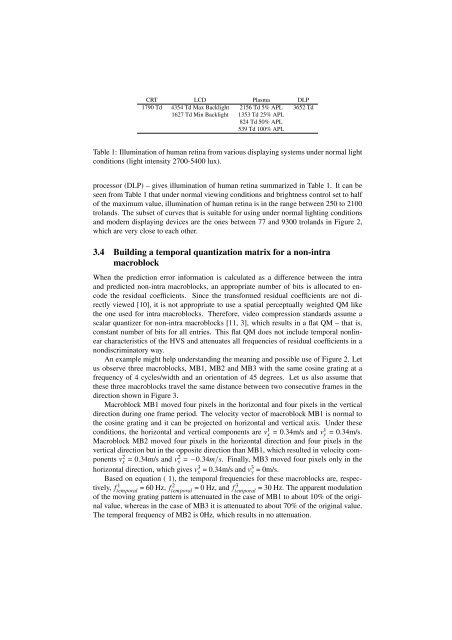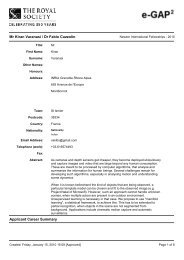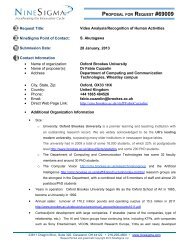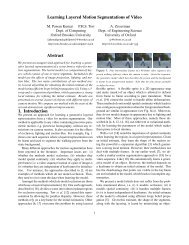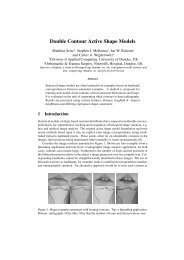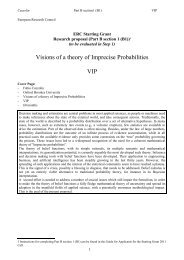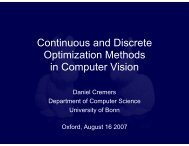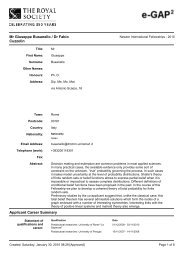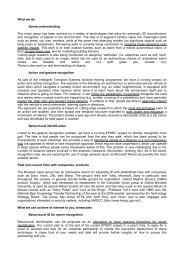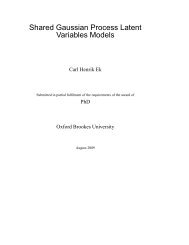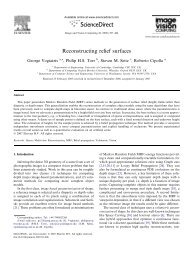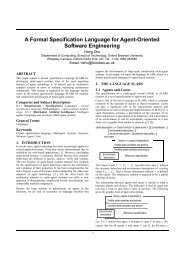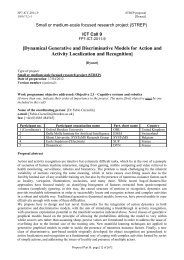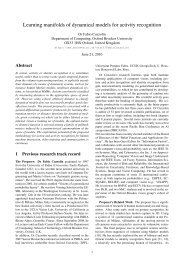Final Copy - Oxford Brookes University
Final Copy - Oxford Brookes University
Final Copy - Oxford Brookes University
Create successful ePaper yourself
Turn your PDF publications into a flip-book with our unique Google optimized e-Paper software.
CRT LCD Plasma DLP<br />
1790 Td 4354 Td Max Backlight 2156 Td 5% APL 3652 Td<br />
1627 Td Min Backlight 1353 Td 25% APL<br />
824 Td 50% APL<br />
539 Td 100% APL<br />
Table 1: Illumination of human retina from various displaying systems under normal light<br />
conditions (light intensity 2700-5400 lux).<br />
processor (DLP) – gives illumination of human retina summarized in Table 1. It can be<br />
seen from Table 1 that under normal viewing conditions and brightness control set to half<br />
of the maximum value, illumination of human retina is in the range between 250 to 2100<br />
trolands. The subset of curves that is suitable for using under normal lighting conditions<br />
and modern displaying devices are the ones between 77 and 9300 trolands in Figure 2,<br />
which are very close to each other.<br />
3.4 Building a temporal quantization matrix for a non-intra<br />
macroblock<br />
When the prediction error information is calculated as a difference between the intra<br />
and predicted non-intra macroblocks, an appropriate number of bits is allocated to encode<br />
the residual coefficients. Since the transformed residual coefficients are not directly<br />
viewed [10], it is not appropriate to use a spatial perceptually weighted QM like<br />
the one used for intra macroblocks. Therefore, video compression standards assume a<br />
scalar quantizer for non-intra macroblocks [11, 3], which results in a flat QM – that is,<br />
constant number of bits for all entries. This flat QM does not include temporal nonlinear<br />
characteristics of the HVS and attenuates all frequencies of residual coefficients in a<br />
nondiscriminatory way.<br />
An example might help understanding the meaning and possible use of Figure 2. Let<br />
us observe three macroblocks, MB1, MB2 and MB3 with the same cosine grating at a<br />
frequency of 4 cycles/width and an orientation of 45 degrees. Let us also assume that<br />
these three macroblocks travel the same distance between two consecutive frames in the<br />
direction shown in Figure 3.<br />
Macroblock MB1 moved four pixels in the horizontal and four pixels in the vertical<br />
direction during one frame period. The velocity vector of macroblock MB1 is normal to<br />
the cosine grating and it can be projected on horizontal and vertical axis. Under these<br />
conditions, the horizontal and vertical components are v1 x = 0.34m/s and v1 y = 0.34m/s.<br />
Macroblock MB2 moved four pixels in the horizontal direction and four pixels in the<br />
vertical direction but in the opposite direction than MB1, which resulted in velocity components<br />
v2 x = 0.34m/s and v2 y = −0.34m/s. <strong>Final</strong>ly, MB3 moved four pixels only in the<br />
horizontal direction, which gives v3 x = 0.34m/s and v3 y = 0m/s.<br />
Based on equation ( 1), the temporal frequencies for these macroblocks are, respectively,<br />
f 1<br />
temporal = 60 Hz, f 2<br />
temporal = 0 Hz, and f 3<br />
temporal = 30 Hz. The apparent modulation<br />
of the moving grating pattern is attenuated in the case of MB1 to about 10% of the original<br />
value, whereas in the case of MB3 it is attenuated to about 70% of the original value.<br />
The temporal frequency of MB2 is 0Hz, which results in no attenuation.


